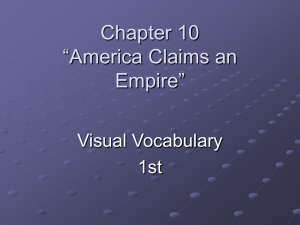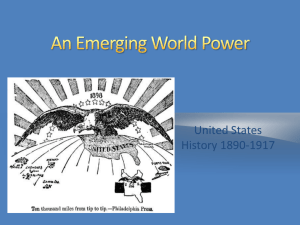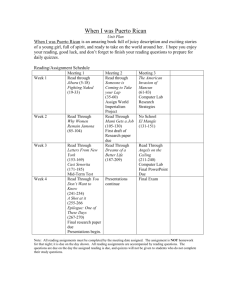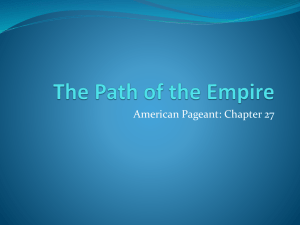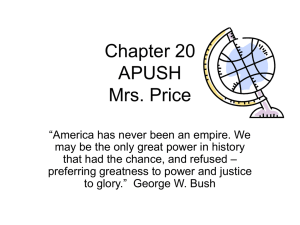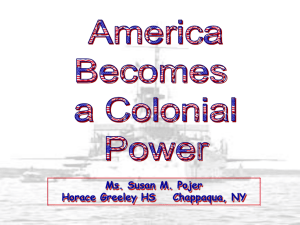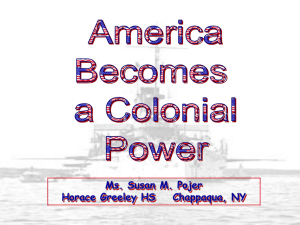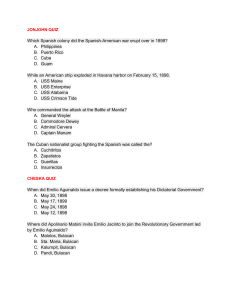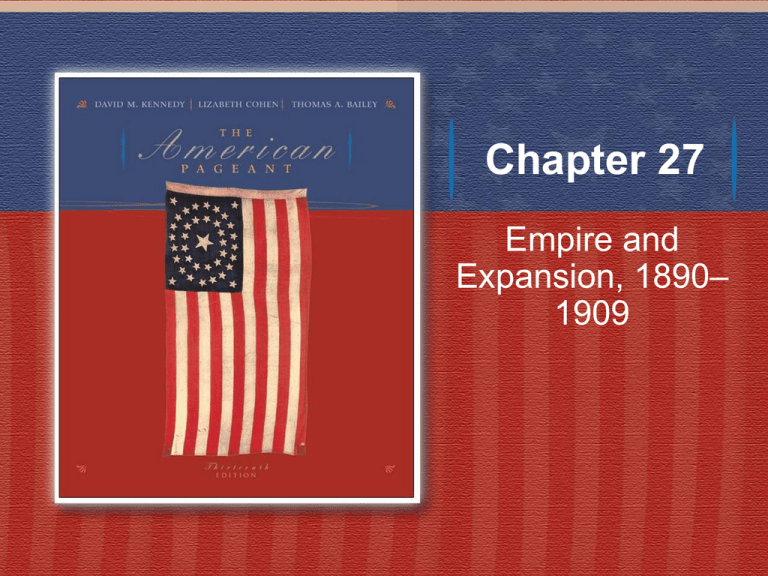
Chapter 27
Empire and
Expansion, 1890–
1909
The Imperial Menu
A pleased Uncle Sam gets ready to place his order with headwaiter William McKinley.
Swallowing some of these possessions eventually produced political indigestion.
The Granger Collection
“Cuba Libre,” by Captain Fritz
W. Guerin of St. Louis, 1898
This elaborately staged tableau depicts
Confederate and Union officers
reconciled three decades after the Civil
War as they join hands to liberate
innocent Cuba from her chains of
bondage to Spain.
Library of Congress
Emilio Aguinaldo (c. 1869–1964) and Followers, 1900
Aguinaldo had a colorfully checkered career. Exiled from the Philippines by the
Spanish in 1897, he was brought back in 1898 to assist the American invasion. A year
later he led the Filipino insurrection against the new American rulers. Captured in
1901, he declared his loyalty to the United States. During World War II, he
collaborated with the Japanese when they occupied the Philippines. After a lifetime of
political intrigue and armed struggle, Aguinaldo died peacefully in Manila in 1964 in
his ninety-fifth year.
© Bettmann/ CORBIS
Colonel Theodore Roosevelt with Some of the “Rough Riders”
Roosevelt later described his first encounter with the Spanish enemy: “Soon we came
to the brink of a deep valley. There was a good deal of cracking of rifles way off in
front of us, but as they used smokeless powder we had no idea as to exactly where
they were, or who they were shooting at. Then it dawned on us that we were the
target. The bullets began to come overhead, making a sound like the ripping of a silk
dress, with sometimes a kind of pop. . . . We advanced, firing at them, and drove
them off.”
The Granger Collection
The Cuban Campaign, 1898
On February 15, 1898, an explosion
destroyed the American battleship
Maine as it lay at anchor in the harbor
at Havana, Cuba. Some 260 Americans
lost their lives. Many Americans blamed
the Spanish government of Cuba,
although there was no evidence to
suggest who was responsible.
Copyright (c) Houghton Mifflin Company. All Rights Reserved.
Uncle Sam and People from His Colonies, c. 1900
The acquisition of Puerto Rico, the Philippines, Hawaii, and other Pacific islands
brought millions of people of color under the American flag. Whether they would
eventually become citizens or remain colonial subjects was hotly debated in the
United States. Many anti-imperialists opposed colonial expansion precisely because
they regarded the exotic new peoples as “unassimilable.”
© Bettmann/ CORBIS
The First Puerto Ricans
The Spanish conquistadores treated the native Taino people in Puerto Rico with
extreme cruelty, and the Indians were virtually extinct by the mid-1500s.
Harvard University
Preparing for Carnaval (Carnival)
This mask-maker displays an elaborate mascara de carton (papier-mache mask)
made for the annual Puerto Rican festival. Masked figures at Carnaval have been
part of Puerto Rican culture for more than two centuries.
Dave G. Houser/CORBIS
Carnaval in New York
Puerto Rican Americans making music
in New York City.
Katrina Thomas
The New Jingoism
An enthusiastic Uncle Sam cheers the
U.S. Navy in the “splendid little war” of
1898. Many Americans, however, were
less than enthused about America’s
new imperial adventure.
The Granger Collection
Captured Filipino Insurrectionists, c. 1899
For three years after its annexation of the Philippine Islands in 1898, the United
States fought a savage war to suppress a Filipino rebellion against American rule.
Some 600,000 Filipinos perished. There was bitter irony in this clash, as the
Americans had claimed to be “liberating” the Filipinos from their oppressive Spanish
masters; now the Yankee liberators appeared to be no less oppressive than the
Spaniards they had ousted.
Library of Congress
American Missionary Grace Roberts Teaching in China, 1903
A long history of American missionary involvement in China nurtured a sentimental
affection for that country among Americans that persisted well into the twentieth
century.
American Board of Commissioners for Foreign Missions Collections, Houghton Library, Harvard University
Filipino Laborers at Work on a Hawaiian Pineapple Plantation, 1930s
Beginning in 1906 the Hawaiian Sugar Planters Association aggressively recruited
Filipino workers. Enlistments grew slowly at first, but by the 1920s thousands of
young Filipino men had reached the Hawaiian Islands and been assigned to sugar
plantations or pineapple fields.
Hawaii State Archives
Filipino Workers Arriving in
Honolulu, 1940s
Tags around their necks indicated the
plantations to which they had been
assigned.
Hawaii State Archives
Theodore Roosevelt
Roosevelt gives a speech with both
voice and body language in North
Carolina in 1902.
© Bettmann/ CORBIS
Japanese Workers Building a Road in California, c. 1910
The Russo-Japanese War, and the promise of economic opportunity, led to an influx
of Japanese immigrants into the spacious valleys of California.
U. S. Army Signal Corps

